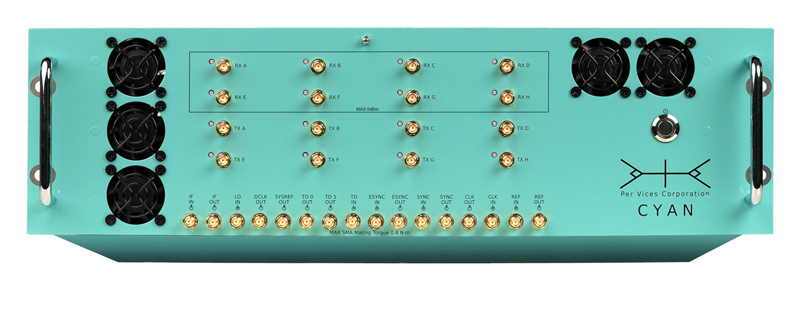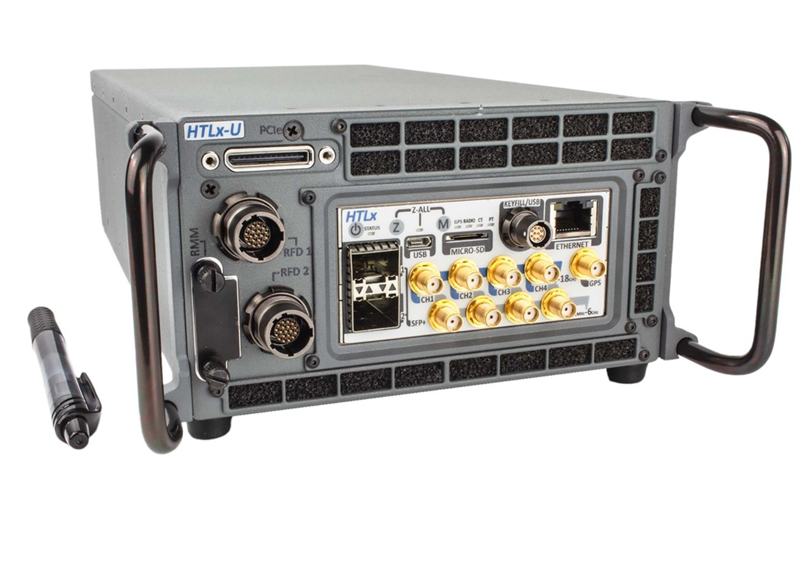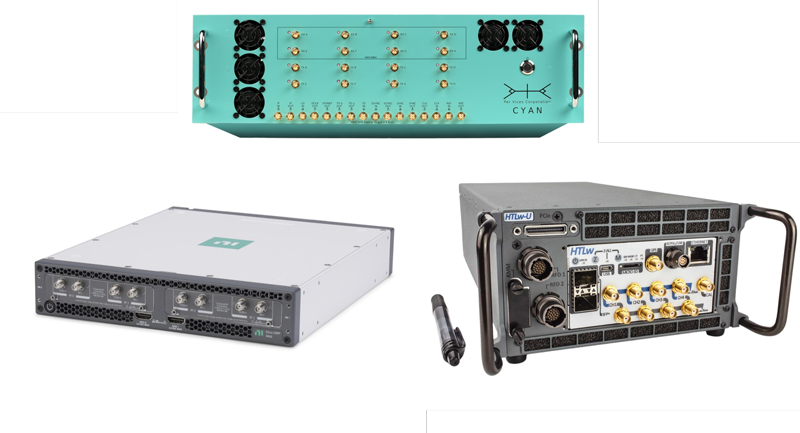Comparing High-Performance Software-Defined Radios
Introduction
Software Defined Radios (SDRs) have revolutionized how radio systems are designed and implemented. With their inherent flexibility and versatility, these transceivers have become increasingly prevalent in various RF applications, including telecommunications, device testing, 5G stations, and the internet of things (IoT). In particular, high-performance SDRs have become an essential tool in critical defense applications such as radar, spectrum monitoring, signals intelligence (SIGINT), electronic warfare (EW), and satellite communications (SatCom). This article aims to compare three top-performing commercial off-the-shelf (COTS) SDRs based on their hardware capabilities, focusing on critical performance parameters such as tuning range, channel count, bandwidth, and digital backhaul. By evaluating these figures of merit, designers can better select the right SDR for their applications, as no solution can fit every possible use case.
While our focus here is the key performance specifications of the top-performing SDRs, it is worth noting that other factors can impact their effectiveness and cost-benefit in specific applications. Factors such as size, weight, power (SWaP), FPGA resources, accessibility, form factor, cost, lead time, and the ability to be modified can all affect an SDR’s performance differently. Depending on the exact requirements of an application, one SDR may offer more benefits than others regarding these characteristics. Nevertheless, we discuss the critical performance specifications essential in the vital applications in EW and defense, including radars, spectrum monitoring, and SIGINT.
Performance Factors
Four key figures of merit are essential when selecting SDRs for EW and defense systems: tuning range, channel count, sampling bandwidth, and digital backhaul. These parameters are crucial in determining the SDR’s ability to operate effectively in these applications. The tuning range defines the range of frequencies that an SDR can receive and transmit signals with nominal gain. A wide tuning range is essential for applications such as spectrum monitoring and electronic warfare, where the ability to automatically tune and quickly switch between different frequencies is crucial for accuracy, safety, and operability. For example, an SDR with a wide tuning range in EW systems can rapidly detect enemy radar systems and automatically tune the Tx chain to generate jamming signals. Likewise, radars can use frequency hopping protocols to avoid jamming. The SDR channel count is another important parameter, which refers to the number of independent radio chains that an SDR can support. In applications such as radar and SIGINT, a high channel count allows for the simultaneous processing of multiple signals, also called multiple-input multiple-output (MIMO) operation. For example, in radar applications, MIMO SDR can simultaneously process numerous radar signals simultaneously, allowing for more accurate target tracking, identification, and beamforming/beam-steering techniques through antenna arrays. The sampling bandwidth defines the maximum frequency range that an SDR can sample, ultimately limiting the range of instantaneous frequency detection per channel. A high sampling bandwidth is essential for applications such as radar and spectrum monitoring, where capturing and processing large amounts of data is crucial. For example, in spectrum monitoring applications, an SDR with a high sampling bandwidth can capture a large portion of the RF spectrum concurrently, increasing the probability of intercepting a signal. The digital backhaul refers to the SDR’s ability to transmit and receive data over a digital interface. This characteristic is particularly critical in applications such as electronic warfare, where the ability to process and analyze large amounts of data rapidly is essential. An SDR with a high-speed digital backhaul can quickly transmit data to other systems for further analysis, processing, and storage with minimum loss of information.
Per Vices Cyan
The Cyan SDR is a high-end COTS SDR with unique features that make it well-suited for a broad range of critical applications. Being the power horse of the Per Vices portfolio, this transceiver boasts a tuning range from near DC to up to 18 GHz, making it ideal for high-frequency applications in EW and radars. The SDR also has a high channel count of up to 16 independent radio chains, allowing for multiple simultaneous Tx and Rx channels, which enables the device to work as an all-in-one solution, or significantly scaling the captured bandwidth in spectrum monitoring by assigning different portions of the spectrum to each channel – with each channel offering either 1 GHz or 3 GHz of instantaneous bandwidth with 32 bit or 24-bit resolution. Regarding dynamic range, the Cyan SDR provides 25-70 dB, with a spurious-free dynamic range (SFDR) of 65 dB. Additionally, the Cyan SDR has a wideband digital backhaul capability of up to 4x40Gbps (or 4x100Gbps in the high bandwidth version) over optical qSFP+ links, providing increased data throughput and low latency for applications such as real-time spectrum analysis and large-scale data acquisition. With these specifications, the Cyan SDR is a powerful tool for high-speed data capture applications, including signal analysis, beamforming, and target tracking. The digital backend is based on the Intel Stratix 10 FPGA SoC, making it highly versatile in terms of available FPGA resources while also providing onboard DSP capabilities that are unmatched and a ready-to-use host interface capable of working with powerful host software applications as well as a host system solution also offered by the manufacturer.

Because of its powerful capabilities, the Cyan SDR may not be the best choice for applications requiring a strictly small SWaP (size, weight, and power) profile. In these cases, other SDR models, such as the Crimson TNG and the Chestnut (also from Per Vices), are more suitable for the job, as they have lower channel counts and smaller form factors while still maintaining high-performance capabilities. Overall, the Per Vices Cyan SDR is a versatile and powerful tool well-suited for a wide range of applications in the defense industry, making it a strong contender in the high-performance SDR markets.
National Instruments USRP X410
The next SDR in our list is a powerful representative of the popular Universal Software Radio Peripheral (USRP) family of SDRs, developed by National Instruments: the USRP X410. This device implements a Xilinx Zynq-Ultrascale+ ZU28DR RFSoC as the digital backend, with 12-bit resolution DAC and 14-bit ADC, providing powerful computation capabilities and fair resolution. It contains 4 Rx and 4 Tx channels in a half-wide RU form factor, which offers high channel density, although the number of channels per device is significantly smaller than the others being compared. Each channel can tune from 1MHz to near 8GHz, with up to 400 MHz of instantaneous bandwidth, which is enough for many applications but is limited in critical scenarios, such as spectrum monitoring. Its relatively low power consumption and form factor make it an attractive option for portable, onboard, and battery-powered applications. Compared to other SDRs, the USRP X410 is particularly suited for applications that require real-time signal processing and rapid prototyping. Its compatibility with popular software platforms like LabVIEW and MATLAB makes it easy for engineers and researchers to develop and test new applications. Regarding backhaul, the USRP X410 offers two QSFP28 ports with 10/100 GbE, providing a solid host interface for high-throughput data communication.
Figure 3: National Instruments USRP X410. Source: https://www.ni.com/pt-pt/support/model.ettus-usrp-x410.html
One of the main advantages of this transceiver is that USRP SDRs, in general, are designed to be open-source, enabling users to modify and customize the firmware and software to meet their specific needs. USRP SDRs offer a powerful and flexible platform for RF experimentation and development. However, the USRP X410 is limited regarding channel count compared to other high-performance SDRs, like the Cyan. This may make it less suitable for applications that require a high number of independent RF chains. Its bandwidth is also not as high as some other SDRs on the market, although 400 MHz of instantaneous bandwidth is sufficient for many applications. Overall, the USRP X410 is a powerful and flexible SDR well-suited for a wide range of applications in the defense and telecommunications industries.
Herrick Labs HTLw
Herrick Labs HTLw is another high-performance SDR with exceptional application capabilities, including radar, electronic warfare, and spectrum monitoring. Its tuning range extends from 20 MHz to 18 GHz with instantaneous bandwidth up to 1 GHz per channel. With four Rx and four Tx channels, it may not match the channel count of Per Vices Cyan, but it offers a more focused and dedicated solution for specific applications. A significant advantage of the HTLw is its low phase noise, which, combined with the high bandwidth, makes it ideal for applications that require accurate and reliable frequency measurements, such as spectrum monitoring. The digital backend provides a powerful FPGA with integrated ARM9 cores with NEON coprocessors, capable of implementing modern waveforms and heavy signal processing. Regarding digital backhaul, the HTLw provides 2×10 GbE Ethernet ports, meaning that it supports lower throughput of data than the other SDRs in our list and limits the utility of the high bandwidth unless the processing is completed onboard the device. The HTLw also provides a significantly small form factor, which makes it suitable for onboard applications and low SWaP requirements.

A significant advantage of this transceiver is its open architecture, which includes an SDK with a board support package to enable fast development of new features and capabilities, making it highly versatile for user adaptations and upgrades. It also provides up to 80dB SFDR at the front end, which is fairly higher than some other SDRs, providing accurate operation and reliable signal integrity.
Conclusion
In this article, we compared three top-performing COTS SDRs in the market for critical EW and defense applications such as radar, spectrum monitoring, and SIGINT. We evaluated each SDR based on four key hardware specifications: tuning range, channel count, sampling bandwidth, and digital backhaul. Per Vices Cyan, NI USRP X410 and Herrick Labs HTLw have been compared, and each one demonstrated exceptional hardware capabilities in the analyzed parameters and a broad applicability range in the target industry.
The table shows that the Per Vices Cyan has the highest instantaneous bandwidth and the highest number of channels of all three, making it very suitable for radar, spectrum monitoring, SIGINT equipment, jammers, anti-jammers, and general EW devices. The high bandwidth also makes it useful for processing large amounts of data in real-time, which is further enabled by the powerful qSFP+-based backhaul. However, it may not be the most suitable option for applications with size, weight, and power (SWaP) constraints. The Herrick Labs HTLw, for instance, provides similar frequency specifications with a much smaller form factor at the cost of lower channel count and digital backhaul throughput, making it better suited for applications that require very low SWaP and high-frequency performance. The HTLw provides higher SFDR, which is excellent for increased accuracy and precision. However, the backhaul speed is lower than our other contestants, which may be a limitation for high-speed applications with vast amounts of data. Although the NI USRP X410 provides slightly less overall performance in terms of frequency, its small form factor and open-source architecture make it an excellent choice for fast prototyping and non-critical applications, as it offers more onboard development. Comparing the top-performing SDRs for these applications, all three transceivers provide impressive capabilities and features. While each SDR has pros and cons, understanding the performance parameters and their application-specific benefits is crucial when selecting the most appropriate solution for a particular use case.
| SDR | Core | Tuning Range | Resolution | SFDR | Channel Count | Bandwidth | Digital Backhaul | Form Factor |
| Per Vices Cyan | Intel Stratix 10 SoC / ARM Cortex-A53 MPCore | Near DC to 18GHz | 32-bit
|
60dB
|
16 Tx/Rx | 3GHz per channel | 4x 40/100 Gbps
qSFP+ |
19” 3U
482.6 x 402.0 x 133.0mm
6.2 kg |
| NI USRP X410 | Xilinx Zynq Ultrascale+ ZU28DR RFSoC /
Quad-core ARM Cortex-A53 |
1MHz to 8GHz | 12-bit ADC
14-bit DAC |
– | 4x Tx
4x Rx |
400MHz per channel | 2x 10/100 GbE
qSFP28 |
½ RU
28.5 cm × 22.2 cm × 4.4 cm
2.5 kg |
| Herrick Labs HTLw | Non-specified FPGA with ARM9 Cores/NEON coprocessors | 20MHz to 18GHz | – | 80dB
|
4x Tx
4x Rx |
1GHz per channel | 2x 10GbE Ethernet | – |
Table 1: SDR comparison.
Company Info
Per Vices has extensive experience designing, developing, and building SDRs for radars, spectrum monitoring and recording, data acquisition, signals intelligence, and EW applications. Contact solutions@pervices.com today to see how we can help you with your testing needs.
Note
This article was written based on publicly available information. Any names and trademarks are the property of their respective owners.

